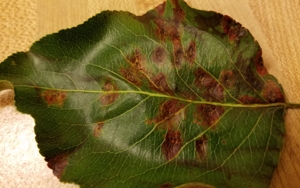Pyrus sp.
Pears are quite productive and relatively easy to grow if the proper varieties are selected and a little effort is put into cultural requirements. There have been as many as 5,000 pear varieties. Current pear choices are a lot more limited, but the selection is still quite wide and comprised of both European and Asian cultivars. Both standard sized pear trees and dwarf versions can often be found at local nurseries, while some of the more uncommon sorts can be mail ordered. Pear trees are a medium-sized tree reaching 33-56' tall with a tall, narrow crown.
European pears came to America with the first English colonists and some varieties are cold hardy to -40ºF. Not only were these trees valued for their fruit but also the wood was used for tool handles and furniture, and the leaves produced a yellow dye. Many of the most popular pear varieties were bred by European growers, although they most likely originated in Asia. ‘Bartlett’ is probably the best known and most widely grown European pear but its susceptibility to a bacterial disease known as fire blight may make it less desirable in some parts of the country than more fire blight resistant varieties. ‘Beurre Bosc’, another older cultivar, is a productive, regular bearer with fruit that ripens in mid to late September.
The ‘Seckel’ pear was discovered as a chance seedling near Philadelphia around 1800. A small, dessert quality pear, it offers good fire blight resistance. Other blight-resistant European pears include ‘Maxine’, ‘Harrow Delight’, ‘Magness’ and ‘Moonglow’. ‘Kieffer’, a natural cross between a European pear and the grittier sand pear of eastern Asia, is another blight-resistant variety but the fruit has large grit cells and is not of high dessert quality. It has been used for making preserves and is likely more closely associated with the Perry pears which are used for making a fermented pear juice which is called perry. Pear brandy is also distilled from this variety.
Although they have been grown for ages in their native Japan and China, Asian pears are still being discovered both in grocery stores and at local nurseries. Most have a yellowish green skin which is sometimes russeted. Asian pears are more rounded and very crisp and juicy, much more like an apple in texture than the dessert pears we are used to eating. There are Chinese and Japanese varieties as well as crosses between the two. ‘Shinko’ and ‘Shin Li’ are two hardy, blight-resistant cultivars. While European pears are harvested green and stored until ripe, Asian pears taste best when allowed to ripen on the tree.
Growing Pears
Pears require a sunny site in a not overly fertile, well-drained soil. They are more tolerant of heavier soils than are apples.
Pruning is done much like it is for apple trees, keeping in mind that pears have a more upright growth habit and the center of the tree should be kept open for good air circulation and increased sunlight.
Two varieties are needed for cross pollination and fruiting to occur. ‘Bartlett’ and ‘Seckel’ will not cross pollinate, so if you plan on growing these two selections, a third variety will be needed to ensure pollination. Asian pears will pollinate European pears but check on the bloom periods, as they must overlap and many Asian pears bloom earlier than the European ones.
Summer and autumn cultivars are harvested before they are fully ripe. Nashi pears are allowed to ripen on the tree.
Diseases and Pests
Major pear pests include pear psylla, pear leafcurling midge, codling moth larvae and as mentioned earlier, fire blight. Pear psylla can be controlled by horticultural oil sprays (before buds open or 2-3 weeks after petal fall), pear leafcurling midge with Bacillus Thuringiensis israelensis (Bti), codling moth larvae by timely insecticide applications (5 weeks after petal fall) of Bacillus Thuringiensis kurstaki (Btk), and the branches affected by fire blight should be pruned out 12 inches below the site of infection. Compared to many tree fruits, a good crop of pears can be obtained with relatively few sprays.

Pear Trellis Rust is caused by the fungus Gymnosporangium sabinae. The disease can cause losses in pear crops and impact the health of ornamental pear trees.

Despite good cultural practices, pests and diseases at times may appear. Chemical control should be used only after all other methods have failed.
For pesticide information or other questions please call toll free: 877-486-6271.
Revised by UConn Home and Garden Education Center 2016.